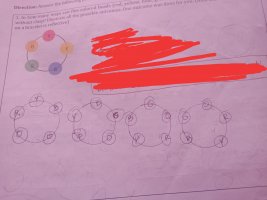You are using an out of date browser. It may not display this or other websites correctly.
You should upgrade or use an alternative browser.
You should upgrade or use an alternative browser.
In how many five colored beads be arranged on a bracelet
- Thread starter hhehehehe
- Start date
BigBeachBanana
Senior Member
- Joined
- Nov 19, 2021
- Messages
- 2,181
What have you tried? Please share your thoughts/attempts.
BigBeachBanana
Senior Member
- Joined
- Nov 19, 2021
- Messages
- 2,181
You're partially correct. You'd also have to consider that they're reflexive.I tried (5-1) = 4! = 24 since there's one already but I'm not really sure how to illustrate the possible outcomes or if 24 is correct
Let's start from the beginning.
You have 5 different coloured beads. Position 1 can be any of the 5 beads. Position 2 can be any of the 4 remaining beads, and so on...
Therefore, we have 5x4x3x2x1=5! ways. However, we also have to consider the symmetries: rotations and reflections.
Once you've assembled your bracelet, the positions of the beads can be rotated clockwise or counterclockwise when it's on your wrist, but in the end, it's still the same permutation. More formally, two permutations are identical if each bead has the same left and right neighbours but not necessary in the same position. There are 5 ways you can rotate the positions of the bracelet, so we need to remove 5 ways.
[math]\frac{5!}{5}=4![/math]
Next, we're going to consider reflexive symmetry. If you remove your bracelet from your wrist, flip it around and put it back on, it's still the same permutation, again, because each bead has the same left and right neighbours, but it's not necessary in the same position. Therefore, we need to account for the double-counting by dividing by 2.
[math]\frac{4!}{2}=12[/math]
Alternatively, if you have learned about equivalence classes, the terms symmetric and reflexive should ring a bell. The 2x5 arrangements of the 5 beads make up an equivalence class. Each rotation and reflection within the same "class" is equivalent to the others because they all produce the same permutation. Let r be an equivalence class, and 10 of those make up the total number of arrangement 5!
[math]10r=5!\\[/math][math]\implies r=\frac{5!}{10} = \frac{4!}{2}[/math]
In general, for n distinct color beads, each class will contain 2n equivalent arrangements. Therefore,
[math]2nr=n!\\ \implies r=\frac{n!}{2n}=\frac{(n-1)!}{2}[/math]
PS: You can illustrate by drawing the different bracelet arrangements with colors.
Last edited:
BigBeachBanana
Senior Member
- Joined
- Nov 19, 2021
- Messages
- 2,181
The idea is correct, but there's no need to do the rotations or the reflections due to the reasons I mentioned above. You only need to do the 12 unique arrangements.View attachment 31746
Is this the right way to illustrate possible outcomes?

